“How difficult is this going to be?” asked Metro Morning host Matt Galloway as he climbed into a simulated streetcar at the TTC’s Leslie Barns facility.
A few minutes later he got his answer.
“Is there a horn I can honk at them?” quipped Galloway as an on-screen car cut in front of his replica streetcar.
Galloway will broadcast Metro Morning live from a real streetcar on Tuesday.
He won’t, of course, be driving that vehicle. And for good reason.
“Uh-oh, there’s a stop,” warned Lionel Jordan, a senior TTC trainer, as Galloway forged ahead full-speed in the simulator.
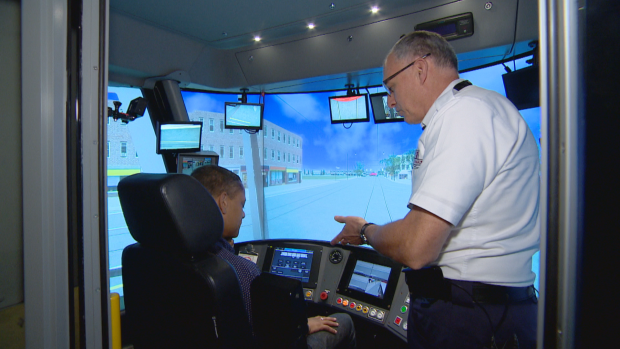
TTC instructor Lionel Jordan gives CBC’s Matt Galloway a few pointers. (CBC)
“It’s very realistic. Although the buildings don’t look exactly like Queen Street, the height of the buildings is accurate, explained Jordan.
Familiar spots are littered throughout the system. It has about 12 replicas of landmarks around Toronto, including city hall and the CN Tower.
‘Any training moment we can dream up’
This gives trainees the chance to practise driving through unexpected, hazardous conditions in a realistic simulation.
“Here we can create any training moment that we can dream up,” Jordan explained, “like training somebody in August how to operate in a snowstorm.”
“We even have racoons available to us,” he said.
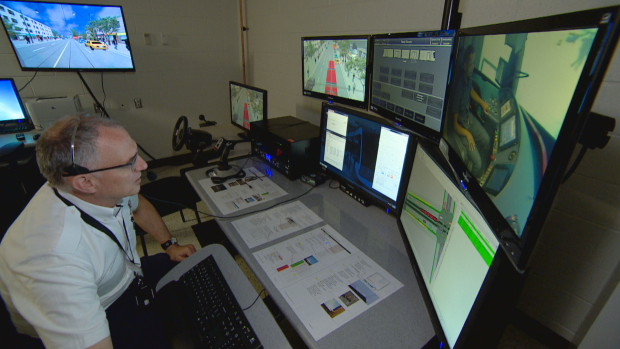
TTC senior trainer Lionel Jordan sits behind control monitors that allow him to monitor and manipulate conditions in the simulator. (CBC)
“I can control the scenario that we’re actually trying to teach whether it’s just learning to move the car for the first time or trying to get by an emergency vehicle, through a construction zone, or operating in a tunnel where you might come upon workers at track levels, ” said Jordan.
He admits it can sometimes be fun to throw unexpected situations at new drivers but adds it’s always better to ease them in slowly.
“I try to stay away from throwing everything all at once. I want them to actually go drive the new car and not be too scared of it,” he explained.
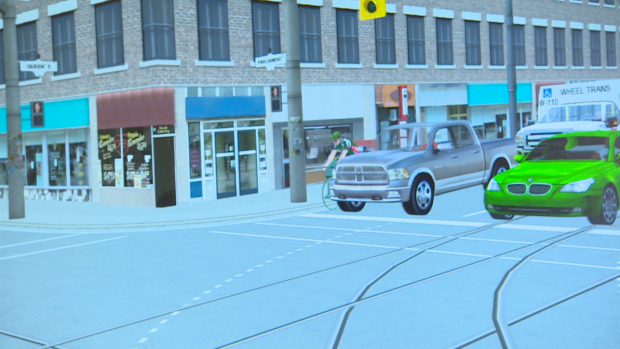
The TTC’s low-floor streetcar simulator has mostly generic street settings with about 12 replicas of landmarks around Toronto, including the city hall and the CN Tower. (CBC)
To stop the car in time, however, there is no foot brake. Everything in the vehicle is hand controlled.
‘No reset buttons’
“There are no foot pedals for the operator to push, no brake pedals, no accelerator. It’s just a handle they use to make the car go and stop,” Jordan said. “This is the first time we’ve have used hand controls since the 1920s.”
The master control looks similar to a video-game joystick. Jordan says, in the simulator, if trainees make a mistake, he can simply hit a reset button.
“In real life though, there are no reset buttons,” he cautioned.
He says some of the biggest mistakes rookies make are not paying attention to motorists that drive alongside the light rail vehicle and stop too closely behind vehicles.
The issues that usually stump them the most are when things like doors, brakes and even the computer malfunctions on the car.
“This vehicle is computer driven. You’re actually not driving the car, you’re asking the computer to do certain things and then the computer tells the car that’s what you’ve asked for,” said Jordan.
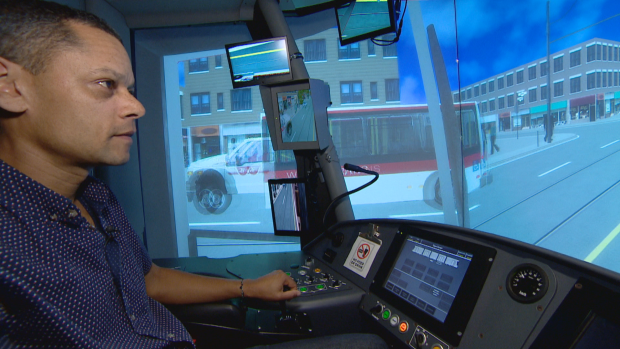
Galloway tests his driving skills on the TTC’s streetcar simulator at Leslie Barns. (CBC)
There is another feature that beeps every 15 seconds. If the operator doesn’t hit a button to stop the beeping, the streetcar brakes immediately. This is in place to ensure the drivers are vigilant.
Operators are required to stay alert at all times because there are a number of cameras to monitor at all times.
There are no mirrors on the vehicle, just cameras that “gives a nice view down the 100 feet of the vehicle,” said Jordan.
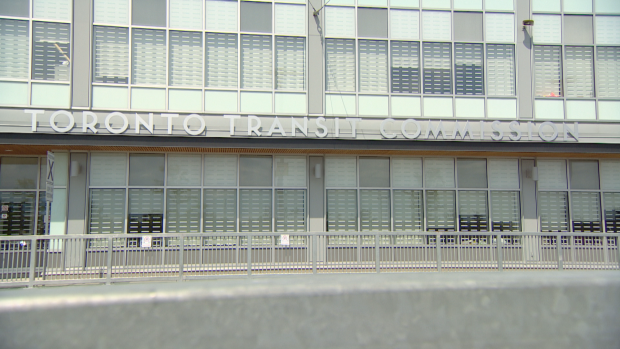
The TTC’s Leslie Barns car house and training facility launched in 2016. (CBC)
Leslie Barns is the TTC’s streetcar carhouse at Leslie Street and Lake Shore Boulevard E. It’s the only location with a low-floor streetcar simulator like this.
Metro Morning is hitting the road on Tuesday, Sept. 5, broadcasting live from a moving streetcar. As the school year begins and we forge ahead with new routines after the summer, [they] explore changes happening in the city this fall — telling stories of people, neighbourhoods and institutions that are moving forward. Listen live 5:30 a.m. to 8:30 a.m. on CBC Radio One 99.1.
Source: CBC News
